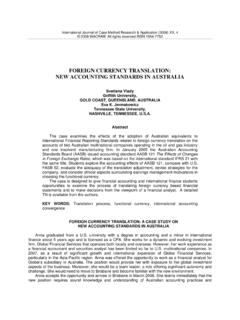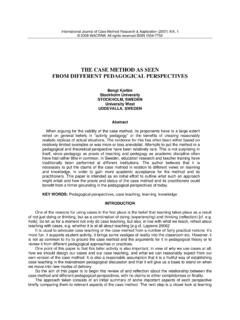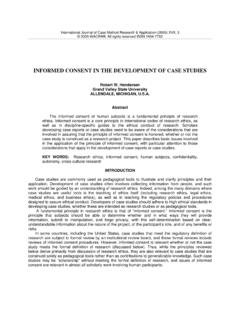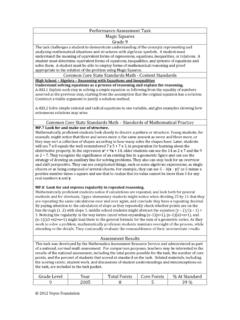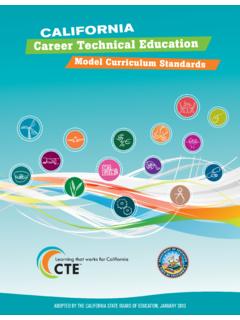Transcription of STREAMLINING THREADED DISCUSSIONS IN ONLINE …
1 International Journal of Case Method Research & Application (2006) XVIII, 1. 2006 WACRA . All rights reserved ISSN 1554-7752. STREAMLINING THREADED DISCUSSIONS IN ONLINE COURSES. Beate Baltes University of Phoenix ONLINE LOS ANGELES, CALIFORNIA, Linda Smedley National University LOS ANGELES, CALIFORNIA, Abstract The development of computer and Internet technologies offers new opportunities for teaching and learning. With the growing use of ONLINE courses and virtual DISCUSSIONS in hybrid and ONLINE courses, there is a distinct need for students and ONLINE instructors to address the importance and learning value of THREADED DISCUSSIONS and to propose tools for assessing and STREAMLINING effective DISCUSSIONS . KEY WORDS: THREADED discussion , ONLINE teaching, effective ONLINE courses, STREAMLINING THREADED DISCUSSIONS INTRODUCTION. ONLINE education continues its growth.
2 While the Sloan Consortium suggested last year that ONLINE education penetrates institutions of higher learning, it provided more precise data in the 2005 report: Sixty-five percent of schools offering graduate face-to-face courses also offer graduate courses ONLINE with almost as many undergraduate schools following this trend. Allen and Seaman state that the overall ONLINE enrollment increased from million students in 2003 to million students in 2004 [Allen &. Seaman, 2005]. Consequently, more and more faculty will teach ONLINE . The authors of this paper are particularly interested in the additional learning that could be generated by virtual DISCUSSIONS in THREADED discussion forums and ways that faculty can use to facilitate meaningful DISCUSSIONS within a reasonable time limit. On the one hand, THREADED DISCUSSIONS create new knowledge that emerges from an active dialog among group members who are sharing ideas and information.
3 On the other hand, the exponentially increasing number of daily postings in THREADED discussion forums suggests that there is a distinct need to investigate how to streamline virtual communication. Neither instructors nor students can be expected to spend several hours a day just reading posted messages in an ONLINE course . SIGNFICANCE OF THREADED DISCUSSIONS . The integration of technology for educational purposes provides universities with powerful tools not only for the delivery of courses to geographically distant students, but also for enhancing classroom learning. ONLINE education should not be understood as the downloading of information followed by the passive and solitary activity of staring at a computer screen. Instead, ONLINE education advances the pedagogical principles of constructive learning through providing opportunities for socio-cultural interaction.
4 30 International Journal of Case Method Research & Application (2006) XVIII, 1. Hicks, Reid, and George [1999], for example, considered THREADED DISCUSSIONS a learning opportunity by increasing quantity and quality of interactions, increasing independent and democratic' interaction, increasing personal reflection, and promoting collaborative and group learning. Bazillion and Brown [1998] described these learning opportunities in even greater detail: (a) students actively construct knowledge by exploring web sites, experimenting with search engines or new ways of seeking information, manipulating things, and engaging in discussion ; (b) students explore other learning styles and find out what works best for their cognitive abilities; (c) students work not only with the teacher, but also among themselves which leads to additional learning; (d) students improve their critical thinking skills by examining ideas found on the World Wide Web and using the entire class time for critical analysis of a topic rather than information delivery; (e) students gain better understanding of a topic by searching for more web sites and exploring different perspectives of a subject.
5 And (f) students learn how to learn. Fundamental to every computer mediated communication system is the concept of utilizing technology to simulate the human communication process. Obviously, emphasis should be on simulating constructive human communication between instructors and students and not a traditional lecture in which students are passive recipients of knowledge [Brown, Collins, and Duguid, 1989; Jonassen, 1996]. Over the last few years, some general rules for facilitating virtual discourse (as well as face-to-face interaction) have been established [for example, Baltes, 2001; Gunn, 2001; Graham, Gagiltay, Lim, Cramer, & Duffy, 2001; National Teachers Enhancement Network, 1999]: Instructors need to be available to students and stay in continuous communication so that students can feel the presence of the instructor. Recommendations range from logging into the ONLINE course at least twice daily on all seven days of the week to one login per day on at least five days of the week.
6 Instructors need to develop an open, sharing and collaborative environment among students. This can be achieved through posting biographies, conducting group assignments, and sharing assignments for constructive feedback. Baltes in particular recommended that instructors show their humanness and personality, including humor and authentic concern for the students, rather than trying to hide it behind virtual walls. Instructors need to ensure that students are actively engaged in the learning process by designing a course based on constructivistic principles (see above). In a well functioning ONLINE course , instructors start the discussion on a particular topic, but then retreat to the role of facilitator whose primary role is to guide the DISCUSSIONS towards the topic objectives, to entice critical reflection, and to encourage student participation.
7 Instructors need to provide prompt and relevant feedback. As we know from face-to-face classrooms, there is nothing worse for students than submitting a written assignment that is returned to them without helpful and constructive comments. Students should be informed about their progress through formal and informal means. Instructors need to establish realistic time line for all learning activities. This might just require fewer group activities than in a face-to-face classroom. The emphasis should be on quality rather than quantity. Instructors need to establish, communicate, and enforce high expectations for all learners, especially since in the early years of ONLINE learning, students signed up for ONLINE courses in the hope for an easier version of the face-to-face course . Instructors need to build upon the diversity in experiences and talents that students bring to an ONLINE environment.
8 Instructors need to communicate privately with students experiencing difficulties, students demonstrating inappropriate behavior, or students not actively contributing to the course DISCUSSIONS . Baltes suggested that instructors keep a tally on the personal information that students share in their introductory biography and throughout the course . In the event of a problem, a more personal and caring approach to solving the problem can be taken (for example, extending the due date due to an illness within the student's family). To at least collect some basic data on how well students are communicating ONLINE and on ground, one of the authors of this paper taught a course called Educational Foundations in the traditional face-to- face situation as well as in an ONLINE environment. The course is part of a California teacher-credentialing International Journal of Case Method Research & Application (2006) XVIII, 1 31.
9 Program. To allow for a basic quantitative comparison, the course content, the reading requirements, the assignments, the visuals, etc. were kept the same. Then, the video taped face-to-face discussion about various goals of education was compared to excerpts from the THREADED discussion . The traditional classroom had nineteen students enrolled. The five different goals of education were discussed for two hours out of a forty hours course . In these two hours, only eight students participated in the discussion and all answers or comments were directed towards the instructor. The ONLINE course had 20 students enrolled. The diverse goals of education were discussed for three days out of a four weeks course . In these three days, seventeen different students posted 42 comments about their point of view on the goals of education. The instructor only intervened seven times with leading questions.
10 Some of the students provided Hyperlinks to additional materials on the Internet or discussed examples from their daily school practice. In the traditional classroom, some students process the presented information immediately and respond with interesting and valuable comments; other students might have interesting comments, but not right away; and some students talk all the time without having anything to say. Asynchronous conversations in an ONLINE course , however, allow every single student to participate in the class discussion without being forced to an immediate response, without being interrupted by another student, or being cut off by the sound of the school bell. Students have time to think before responding to their class members' opinions and they do not have to wait for the next class to express their views, yet they can participate in the communication when they are in "top form" rather than during a preset class hour that follows a long day of work or a long night at the campus party.


